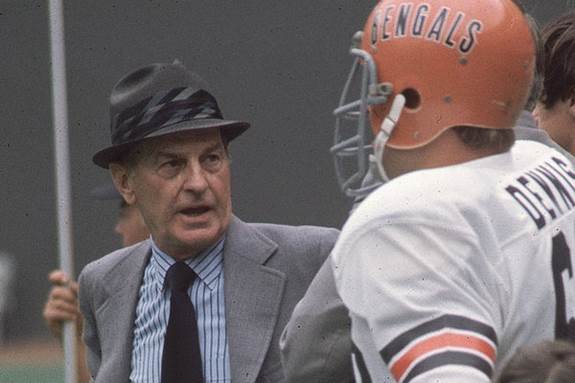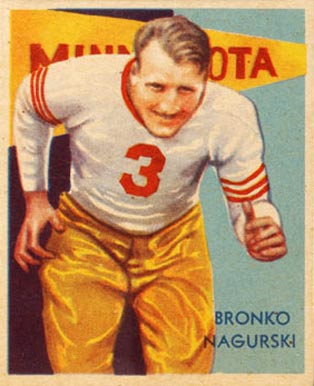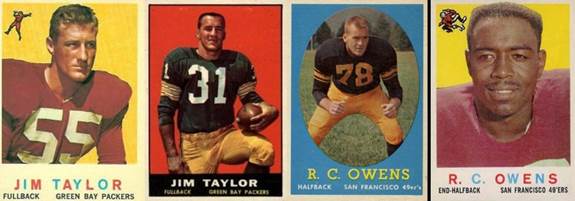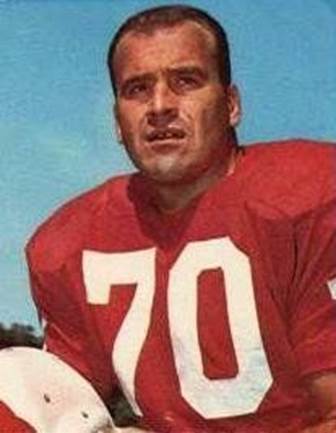

COLLECTIBLE CARDS, "DEAL ME IN, BUT JUST A LITTLE BIT"
HELMET HUT NEWS/REFLECTIONS September 2016:
COLLECTIBLE CARDS, 'DEAL ME IN, BUT JUST A LITTLE BIT"
By Dr. Ken
Jack Clary presented a
distinctively human view
of the great Paul Brown
I can recall that during my
pre-teen years in the
mid-1950s, because baseball
was still the nation’s
dominant and most popular
sport, it was of course “all
about the baseball cards”
that drove card related
conversation, trading, and
among older men in the
neighborhood, buying and
selling. We would hear about
the incomprehensible value
of “the Honus Wagner card”
or a Ty Cobb version but
even in the 1950s and
especially to young boys, it
seemed as if these “names
only” had played four
hundred years ago! I had a
baseball card collection
like every other boy in
school, on the block, or in
the neighborhood, won and
lost at the various games we
played, and ardently traded
when there was a specific
player or card of interest
that came available. It
seemed that football cards
did not become popular or at
least more accessible until
the mid-1950s but these
immediately crippled any
interest I had in baseball
cards. There were a few
older teens or fellows in
their twenties that seemed
to possess some expertise
about the new football cards
and our rag-tag group
learned that as there were
baseball cards of “those
really old guys,” there had
actually been football cards
published and traded dating
to the 1930s. It did not
take long to hear about a
Bronco Nagurski card that
supposedly had great worth,
although like baseball
legend Honus Wagner, Bronk
was really no more than a
name to us.
In today’s market that
Nagurski card still has
great worth but the
$250,000.00 it might
fetch does not compare
to the multiple millions
the market demands for
the rarest of baseball
cards. Some of the
valued cards for us, at
least related to players
we had heard of even
though they were
retired, were of the
status of Sid Luckman
and Sammy Baugh. The
“new” cards of the
mid-1950s reflected our
interest in those who
were actively playing
and who were popular to
the average fan. Unitas,
Brown, Bednarik and
others could be followed
on the radio and less
often on television but
the cards had meaning
with no thought or
actual knowledge of
monetary value.
I was reviewing a few
of the early 1960s
professional football
seasons, with last
month’s Helmet
News/Reflections being
the result [ see
HELMET HUT
http://www.helmethut.com/Features/Dr.Ken154.html
] when my attention was
drawn to a number of the
1962 cards that
displayed errors. In
this specific grouping
of the Topps cards, an
action photo accompanied
each of the individual
player’s photos and a
number of these were so
blatantly incorrect that
they literally jumped
off of the page. I found
a note I had made quite
a few years ago
indicating some of these
errors, a note that I
never followed up on.
Errors on baseball and
football cards are
certainly old news to
collectors and perhaps
those interested in
football history. The
usual mistake is the
misidentification of a
player and some of the
“time honored” ones
include:
Jim Taylor,
a center and linebacker
out of Baylor who toiled
for the Steelers in ’57
and with the Chicago
Cardinals in 1958 and
’59 identified as “Jim
Taylor, fullback, Green
Bay Packers” in both the
1959 and 1960 card sets.
Two-way tackle Don Owens
who played for the Redskins
and Eagles before becoming
established as a reliable
player with the Cardinals
for four seasons was
pictured on the Forty Niners
rookie card of Raleigh
Climon “R.C.” Owens in 1958.
For rather obvious reasons
other than the sixty pound
weight difference between
these men, this error should
have been avoidable!
Two-way tackle Don Owens
is still considered one
of the all-time best at
Southern Mississippi and
was effective as an
offensive tackle in the
NFL
Jack Clary is one of the
truly prolific football related
authors, a free-lance
sportswriter following his many
years in the newspaper business.
He is perhaps best known for
coordinating the media
activities for the Cincinnati
Bengals’ two 1980s decade Super
Bowl appearances and his great
biography of idol Paul Brown.
One of his less known books is a
coffee table sized volume
descriptively titled The
Complete Picture Collection, A
History Topps Football Cards
(1956 – 1986). I am not a card
collector although I frequently
look through Clary's book on the
history of the Topps football
line of cards and have kept a
few treasured items from my
youth. For those who collect
football or baseball cards, the
hobby can be an all-encompassing
passion with few boundaries. My
own attraction to this
particular book is the ongoing
opportunity to review specific
players’ photos from different
seasons and then allow the
memories to wash over me. This
is certainly the “no expense”
way of continuously enjoying
what otherwise can be a bank
wrecking pursuit!



